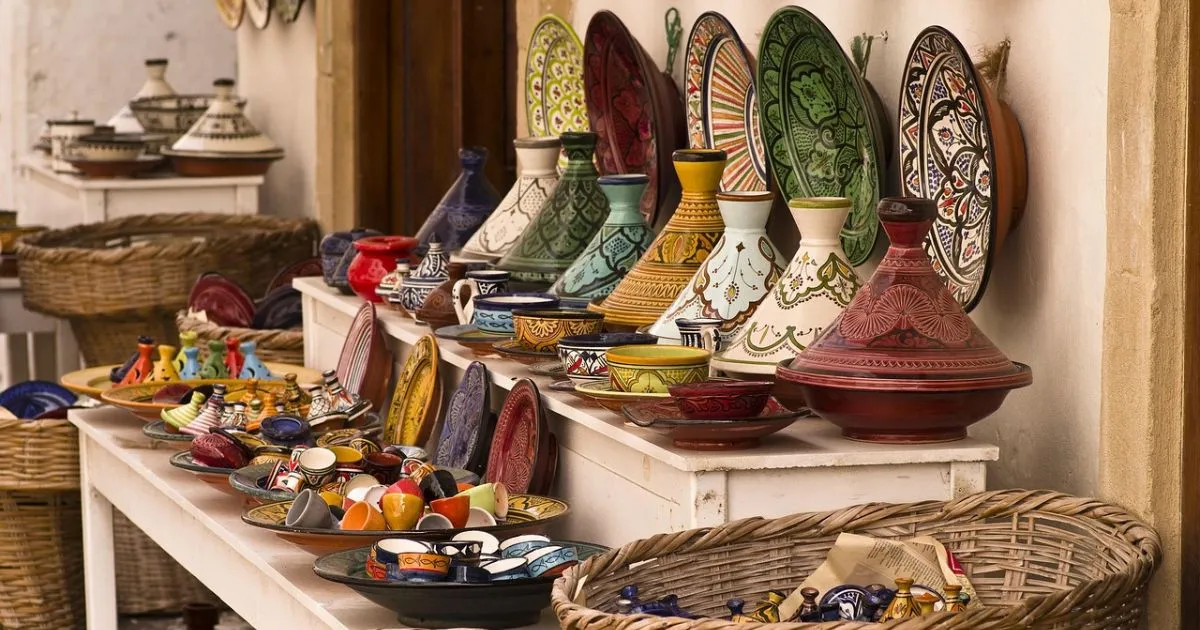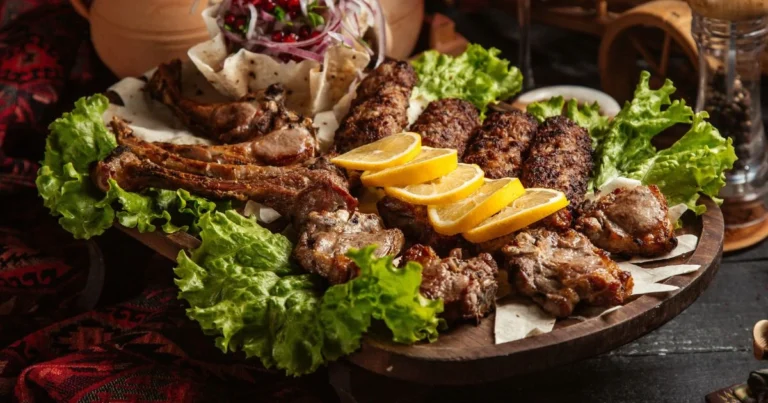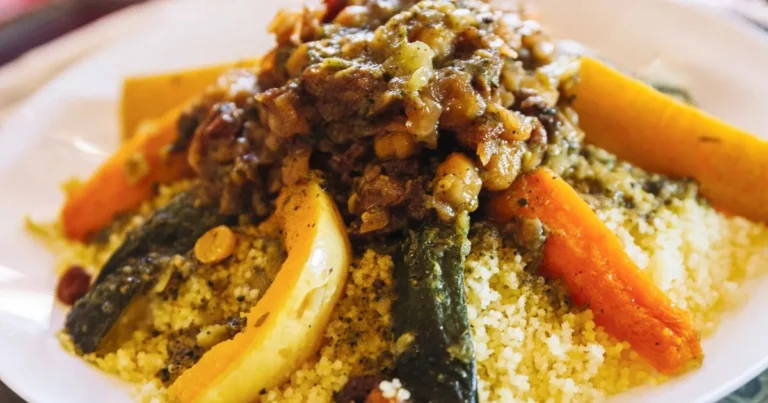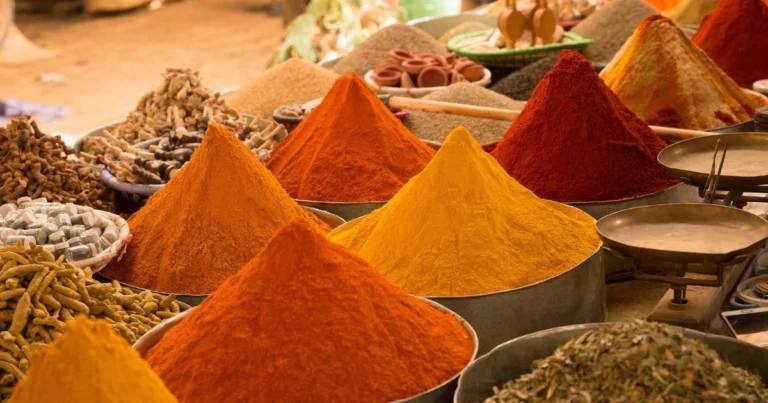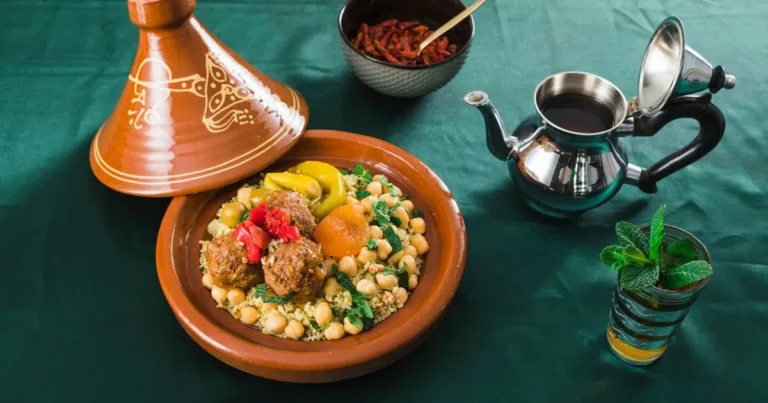Moroccan cooking: 5 Tips on how do I use a tagine
Table of Contents
Moroccan cooking
Using a tagine is key for cooking authentic Moroccan cooking. This classic clay pot features a cone-shaped lid. It helps distribute heat evenly, making meals tender and full of flavour.
Wondering how to start with tagine cooking? It’s easier than you think. With a few simple tips, you can make delicious, authentic Moroccan meals. These will surely impress your loved ones.
Key Takeaways
- Choose the right ingredients for your tagine dishes.
- Grasp the significance of layering ingredients properly in a tagine.
- Learn how to adjust cooking times and temperatures.
- Explore the advantages of using a tagine for slow-cooked meals.
- Explore traditional Moroccan recipes for inspiration.
Understanding the Tagine: Vessel and Dish
The tagine is a cornerstone of Moroccan cuisine.It has a long-standing history and is deeply rooted in the culture. It’s not just a pot; it’s a symbol of Moroccan heritage. It’s a key to preparing traditional tagine cooking passed down through generations.
The History and Cultural Significance of Tagines
The tagine originates from North African cuisine, tracing its roots back to the ancient Berber tribes.It has become an essential element in Moroccan tagine recipes. The tagine’s design allows for slow cooking, which tenderizes meat and blends flavors.
In Moroccan culture, the tagine is more than a cooking vessel. It’s a centerpiece for family gatherings and social events. Cooking and sharing a tagine meal shows hospitality and respect for guests.
Anatomy of a Traditional Tagine Pot
A traditional tagine pot has two main parts: the base and the lid. The base is heavy, made of clay or ceramic, with a wide, shallow bottom. The lid is conical, designed to allow steam to condense and drop back into the dish. This design ensures even heat distribution, cooking food slowly and thoroughly.
| Component | Material | Function |
| Base | Clay or Ceramic | Holds the food while ensuring uniform heat distribution. |
| Lid | Clay or Ceramic | Condenses steam and returns moisture to the dish |
Different Types of Tagine Dishes in Moroccan Cuisine
Moroccan cuisine features a diverse array of tagine dishes. Every dish features a unique combination of flavors and ingredients. Popular Moroccan tagine recipes include lamb tagine with apricots and almonds, chicken tagine with preserved lemons and olives, and vegetable tagine with chickpeas and couscous.
- Lamb tagine with dried fruits and nuts
- Chicken tagine with aromatic spices and herbs
- Vegetarian tagine with a variety of vegetables and legumes
These diverse tagine recipes show the versatility of the tagine pot. They showcase the depth and richness of Moroccan culinary heritage.
Choosing the Right Tagine for Your Kitchen
To get the most out of tagine cooking, pick a tagine that fits your style. Knowing the pros and cons of different types is key. The right tagine can make your cooking better, letting you enjoy Moroccan flavors and traditions.
Clay vs. Ceramic vs. Cast Iron Tagines
The material of your tagine is very important. It changes how your food tastes and cooks. Clay tagines give a special, earthy taste. They need seasoning before use.
Ceramic tagines are also loved and can be glazed or unglazed. They are simple to clean and capable of withstanding high temperatures. Cast iron tagines keep heat well, perfect for slow-cooking. But, they’re heavy and need care to avoid rust.
Think about your cooking habits when choosing. Clay tagines are great for those who love tradition and are ready for upkeep. Ceramic or cast iron might be better for those wanting something durable and versatile.
Glazed and Unglazed Options: Pros and Cons
The glaze on a tagine impacts its look and how it works. Glazed tagines are easy to clean and might be safer. But, some glazes can have harmful materials.
Unglazed tagines, made from clay, soak up flavors and need seasoning. They need more care but can crack if not looked after.
Decide based on what matters most to you: ease of use, safety, or cooking style. Glazed tagines are good for those who cook a lot.Unglazed versions are ideal for those seeking an authentic, traditional experience
Size Considerations for Different Cooking Needs
The size of your tagine is key. It decides how much food you can make. Smaller tagines are ideal for individuals or couples, offering a perfect size for intimate meals.Larger tagines are suited for families or large groups, accommodating bigger meals.
Think about how often you cook and for how many. If you often have big gatherings, a big tagine is better. For solo cooks or couples, a small one is enough, saving space and food.
Choosing the right tagine material, glaze, and size improves your cooking. It lets you dive into Moroccan cooking traditions. Whether you’re new to cooking or experienced, the right tagine makes a big difference.
Preparing Your Tagine Before First Use
Before you start cooking with your new tagine, it’s essential to prepare it properly. This ensures a long-lasting and flavorful cooking experience. The initial preparation is crucial for creating a non-reactive surface and preventing cracking.
Seasoning a New Clay Tagine
Preparing a new clay tagine by seasoning it is an essential step to get it ready for cooking. Begin by spreading a thin, even coat of cooking oil over the interior surface. This process, also known as “curing,” helps to create a non-stick surface. Use a high-smoke-point oil like vegetable or peanut oil for this purpose.
After applying the oil, allow the tagine to rest for several hours or overnight. Then, use a paper towel to remove any excess oil.
Soaking and Curing Techniques
In addition to seasoning, some tagine owners prefer to soak their clay tagine in water before the first use. This step can help to ensure that the clay is fully saturated, reducing the risk of cracking during cooking. To soak your tagine, immerse it in cold water for several hours or overnight.
Once soaked, dry the tagine completely. Then, apply a layer of oil according to the seasoning instructions.
Safety Precautions for New Tagines
When preparing your new tagine, it’s also important to consider safety precautions. Always handle your tagine with care, as the clay can be fragile. Avoid sudden temperature changes, as these can cause the tagine to crack.
Before setting your tagine over a heat source, make sure it’s on a stable surface that diffuses heat evenly. Never leave it unattended while it’s cooking.
By following these steps, you’ll be able to enjoy a safe and rewarding cooking experience with your tagine. Proper preparation is key to achieving delicious, authentic Moroccan dishes.
Essential Ingredients for Authentic Moroccan Tagine Cooking
Authentic tagine cooking is all about layering flavors. It starts with the right ingredients, like spices, proteins, fruits, and vegetables. Moroccan cuisine is rich and diverse, using ingredients in complex ways. This creates deep, aromatic flavors in tagine dishes.
Traditional Spices and Spice Blends
Spices are key in Moroccan cooking, especially in tagine recipes. You’ll come across spices like cumin, coriander, cinnamon, ginger, and turmeric, among others. Ras el hanout, or “head of the shop,” is a famous spice blend. It can have up to 30 spices, including the ones mentioned, and is crucial in many tagine recipes.
Moroccan food expert Paula Wolfert says, “Ras el hanout is the magic that makes a tagine a tagine.”
“The spice blend is more than just a combination; it’s a well-guarded secret in many Moroccan households.”
- Cumin: Adds warmth and earthiness
- Coriander: Provides a slightly sweet, citrusy flavor
- Cinnamon: Contributes a warm, sweet depth
- Ginger: Adds a spicy, warming quality
- Turmeric: Gives a bright yellow color and a slightly bitter taste
Protein Options: Meat, Poultry, and Vegetarian Alternatives
Tagine recipes can use many proteins, making them great for different diets. You can find lamb, chicken, and beef, or try chickpeas, lentils, or vegetables for a vegetarian option.
| Protein Type | Common Uses in Tagine |
| Lamb | Often used in traditional lamb tagine with dried fruits and nuts |
| Chicken | Commonly used in chicken tagine with preserved lemons and olives. |
| Vegetarian | Chickpeas and lentils are common, as are various vegetables |
Fruits, Vegetables, and Preserves in Tagine Cooking
Fruits, vegetables, and preserves are key in tagine cooking. They add sweetness, texture, and complexity. Dried fruits like apricots and prunes, and preserved lemons, which add a salty, tangy flavor, are common. Carrots, potatoes, and zucchini are also used.
A classic lamb tagine might include apricots and almonds. A vegetarian tagine could have a mix of vegetables and chickpeas. These ingredients enhance flavor and aroma.
How Do I Use a Tagine: Step-by-Step Cooking Guide
Cooking with a tagine is more than just mixing ingredients. It’s all about combining flavors to reflect the true spirit of Moroccan cuisine . To get it right, you need to know the steps to prepare and cook your dish.
Preparing Your Ingredients for Layering
First, prepare your ingredients.Dice the vegetables, season the meat or poultry, and portion out the spices. Having everything ready makes layering easier and faster.
- Chop your vegetables into bite-sized pieces.
- Marinate your protein (if using) in a mixture of spices and olive oil.
- Measure out your spices and have them ready.
The Art of Layering in a Tagine
Layering is key in tagine cooking. It helps flavors mix well and ensures even cooking. Begin by sautéing onions and garlic, then add your protein, vegetables, and spices.
“The key to a delicious tagine lies in how the ingredients are layered. It’s not just about throwing ingredients together; it’s about creating a symphony of flavors.” – Moroccan Cooking Expert
Heat Management and Cooking Times
Controlling heat is vital when cooking with a tagine. Start with low heat to blend flavors, then adjust as needed. Cooking times vary, but aim for at least an hour on low heat.
| Dish Type | Cooking Time | Heat Level |
| Meat Tagine | 1-2 hours | Low |
| Vegetarian Tagine | 45 minutes – 1 hour | Low |
Checking and Adjusting During Cooking
Monitor your tagine regularly and adjust the seasoning or liquid when necessary. This ensures your dish is perfectly cooked and flavorful.
To check, just lift the lid and look. If it’s too dry, add more liquid. If it needs more flavor, adjust the seasoning.
Cooking Surfaces and Heat Sources for Tagine Cooking
Choosing the right cooking surface and heat source is key for authentic Moroccan flavors in tagine cooking. Tagine cooking is versatile, allowing use of different heat sources. Each has its own benefits.
Using a Tagine on Gas Hobs
Gas hobs are great for tagine cooking because they offer consistent heat. Ensure the flame is kept low to prevent uneven heating. Using a diffuser helps distribute heat evenly, preventing hotspots.
Electric Hob Considerations
Electric hobs, including induction, can also work for tagine cooking but need care. Always place a heat diffuser underneath to ensure even heat distribution. Check if your tagine is ferromagnetic for induction cooktops, as it won’t heat up otherwise.
Oven-Safe Tagines: Temperature Guidelines
Many tagines are safe for the oven, perfect for slow cooking. Always follow the manufacturer’s temperature guidelines to avoid damage. When using clay or ceramic tagines, gradually preheat the oven to avoid thermal shock. Cooking at 150°C to 200°C for hours ensures tender and flavorful dishes.
Using a Diffuser for Heat Distribution
A heat diffuser is essential for even cooking, especially on gas or electric hobs. It distributes heat evenly across the base of the tagine. First, place the diffuser on the stove, then set your tagine on it. This simple step improves your tagine dishes greatly.
Three Classic Moroccan Tagine Recipes to Try
Discover the true taste of Moroccan cooking with these three traditional tagine recipes. They highlight the rich and diverse flavors of North African cuisine. From tender lamb to vibrant vegetarian dishes, these recipes will become favorites in your kitchen.
Lamb Tagine with Apricots and Almonds
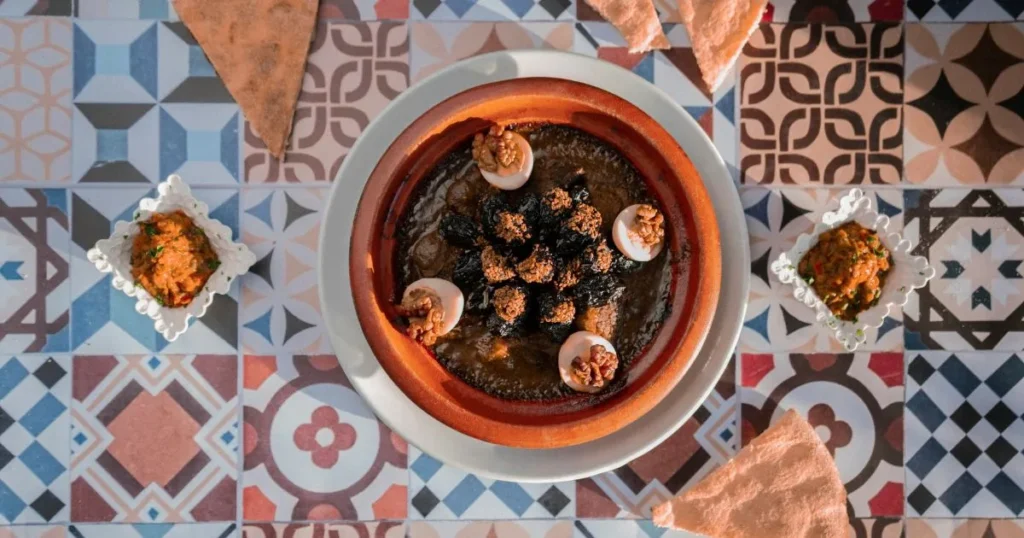
This classic dish is a must-try in Moroccan cuisine. It pairs tender lamb with sweet apricots and crunchy almonds. Here’s what you’ll need:
- 500g lamb shoulder, cut into 2-inch pieces
- 1 large onion, chopped
- 2 cloves of garlic, minced
- 1 cup dried apricots
- 1/2 cup sliced almonds
- 2 tbsp olive oil
- 1 tsp ground cumin
- 1 tsp ground coriander
- 1 tsp ground cinnamon
- Salt and pepper to taste
Start by layering the lamb, onion, garlic, apricots, and almonds in your tagine. Add olive oil and season with cumin, coriander, cinnamon, salt, and pepper. Allow it to simmer over low heat for 2-3 hours, until the lamb becomes tender.
Chicken Tagine with Preserved Lemons and Olives
This chicken tagine is a burst of flavors, with tangy preserved lemons and briny olives. Here’s what you’ll need:
| Ingredient | Quantity |
| 1 whole chicken, cut into 8 pieces | 1.5 kg |
| 2 preserved lemons, chopped | |
| 1/2 cup pitted green olives | |
| 2 cloves of garlic, minced | |
| 1 tsp ground ginger | |
| 1 tsp ground cumin | |
| Salt and pepper to taste |
Layer the chicken, preserved lemons, olives, garlic, ginger, and cumin in your tagine. Season with salt and pepper. Cook on low heat for 1-2 hours, until the chicken is cooked through.
Vegetable Tagine with Chickpeas and Couscous
This vegetarian tagine is a hearty and nutritious option. It includes a mix of vegetables, chickpeas, and light, fluffy couscous. Here’s what you’ll need:
- 1 large onion, chopped
- 2 cloves of garlic, minced
- 2 medium carrots, peeled and chopped
- 2 medium zucchinis, chopped
- 1 can chickpeas, drained and rinsed
- 1 cup couscous
- 2 cups vegetable broth
- 1 tsp ground cumin
- 1 tsp smoked paprika
- Salt and pepper to taste
Layer the onion, garlic, carrots, zucchinis, and chickpeas in your tagine. Add cumin, smoked paprika, salt, and pepper for seasoning. Cook on low heat for 30-40 minutes, until the vegetables are tender. Serve with couscous cooked in vegetable broth.
Troubleshooting Common Tagine Cooking Problems
Mastering tagine cooking is not just about the ingredients or recipe. It’s also about knowing how to fix common problems. Whether you use a clay, ceramic, or cast iron tagine, knowing how to solve issues can make a big difference.
Preventing and Repairing Cracks in Clay Tagines
Clay tagines can crack if not cared for properly.To prevent this, make sure to season your clay tagine before using it for the first time. Soaking it in water for hours or overnight helps.
If your tagine develops cracks, attempt to repair it using a mixture of water and clay powder. Re-fire it if you can. For small cracks, a clay repair kit or food-safe sealant works. But big cracks might mean it’s time for a new tagine.
Solutions for Undercooked or Overcooked Dishes
Getting the cooking time and heat right is key.If it’s not fully cooked, simply continue simmering until it becomes tender. For overcooked dishes, watch the heat and time closely.
To prevent overcooking, use the lowest heat. A heat diffuser can help on gas or electric hobs. For undercooked dishes, cut ingredients right and use enough liquid.
Adjusting Liquid Levels and Consistency
The right consistency is crucial for a great tagine. If it becomes too dry, pour in some water or broth. If it’s too wet, remove some liquid or simmer with the lid off.
For the perfect consistency, remember that tagine cooking is slow. Let it simmer long enough for flavors to blend and sauce to thicken.
Cleaning and Maintaining Your Tagine
Keeping your tagine clean and well-maintained is important. Avoid harsh cleaners that can damage it. Wash using gentle soap and warm water, then thoroughly dry.
Clay tagines need re-seasoning to stay non-stick. Consistent maintenance ensures your tagine stays in excellent condition.
| Issue | Cause | Solution |
| Cracked Clay Tagine | Insufficient seasoning, sudden temperature changes | Repair with clay powder and water, or replace |
| Undercooked Dish | Insufficient cooking time, high heat | Continue simmering on low heat, check ingredient tenderness |
| Overcooked Dish | Excessive cooking time, high heat | Monitor heat and cooking time closely, use a heat diffuser |
| Incorrect Consistency | Too much or too little liquid | Add liquid or simmer with lid off to adjust |
Conclusion: Embracing the Art of Tagine Cooking
Now you know how to use a tagine, and you’re ready to dive into authentic Moroccan cooking. You’ve learned about the history and cultural importance of tagines. This is the first step to making delicious Moroccan meals.
Using a tagine is more than just cooking. It’s a journey from preparing ingredients to layering them in the tagine. With practice, your kitchen will smell like Morocco.
Start experimenting with different ingredients and recipes. Try lamb tagine with apricots and almonds or chicken with preserved lemons and olives. As you get better, you’ll make dishes that feel like a trip to Morocco.
## FAQ
### Q: What is the best way to clean a tagine after use?
To clean your tagine, avoid harsh chemicals and abrasive scrubbers. Immerse it in warm, soapy water and gently clean with a soft sponge. For tough spots, make a paste with baking soda and water, apply, and let it sit before rinsing.
Regular cleaning keeps your tagine in good shape and prevents cracks.
### Q: Can I use a tagine on an induction hob?
Most tagines don’t work well on induction hobs because of their material. But, some cast iron or metal tagines might be okay. Be sure to review the manufacturer’s instructions to confirm. If it’s not compatible, use a diffuser or cook on a different surface.
### Q: How do I prevent my tagine from cracking?
To avoid cracks, don’t change the temperature suddenly and never leave it on high heat alone. Heat and cool it slowly. If it’s clay, season it well. Applying oil to the lid and base helps too.
### Q: What are the benefits of using a glazed versus an unglazed tagine?
Glazed tagines are easier to clean and less likely to crack.However, a chipped glaze can impact the taste. Unglazed tagines need more care but can get a beautiful patina. Choose based on your preference for ease or tradition.
### Q: Can I cook tagine recipes without a traditional tagine pot?
While a traditional tagine is best, you can use other pots for tagine recipes. Dutch ovens or slow cookers work too. But, a tagine’s shape helps keep flavours in. Look for alternatives that can do the same.
### Q: How do I know when my tagine is properly seasoned?
A seasoned clay tagine has a dark, even patina inside. Check after several uses. If it’s still light or patchy, keep seasoning and using it until it’s right.
### Q: Are there any specific safety precautions I should take when using a tagine?
Always be careful with your tagine because it’s fragile. Avoid sudden temperature changes and never leave it on high heat alone. Watch out for steam when lifting the lid, and use gloves or a towel to shield your hands.
### Q: Can I use my tagine for cooking methods other than traditional tagine recipes?
Yes, your tagine is great for slow cooking, braising, or baking. Try different recipes and techniques to see what it can do.

